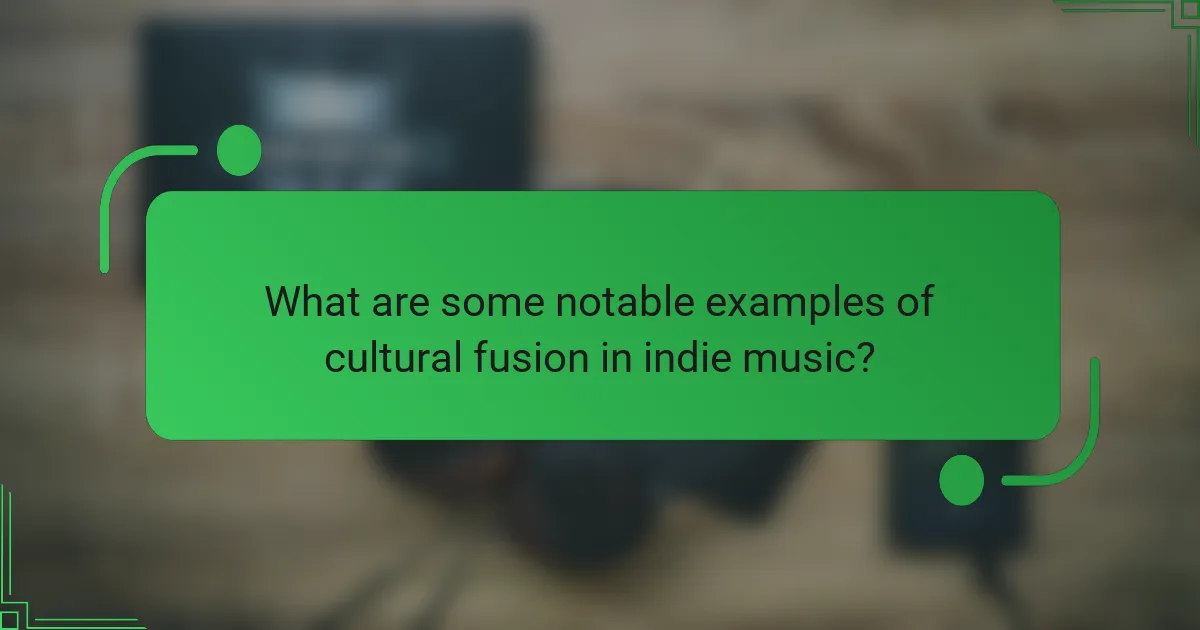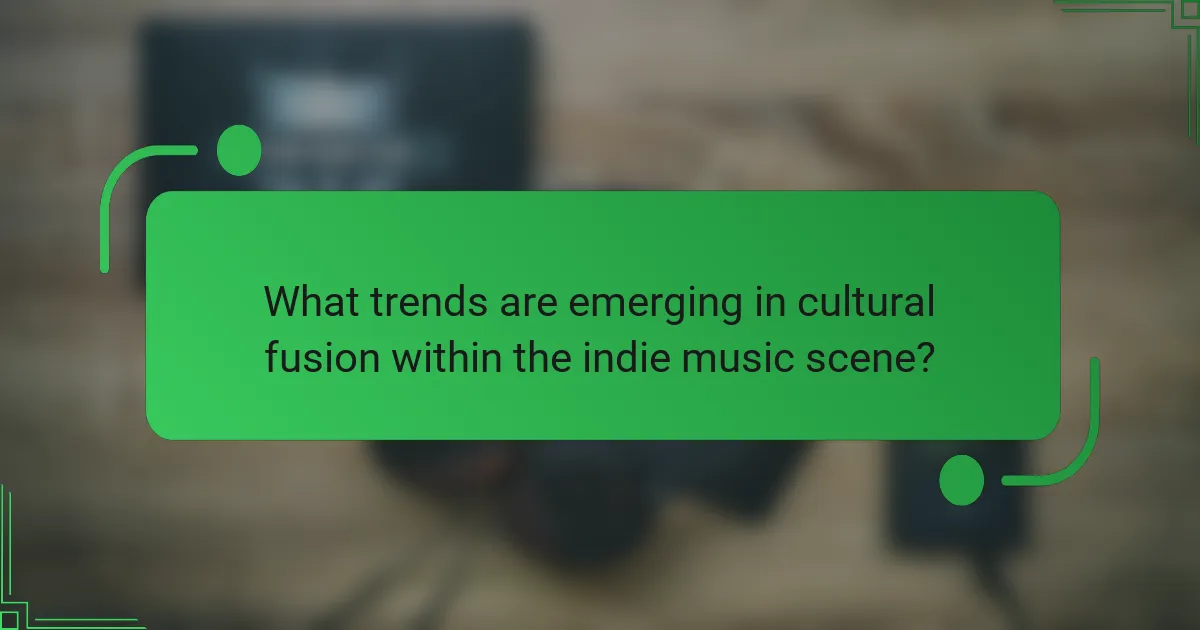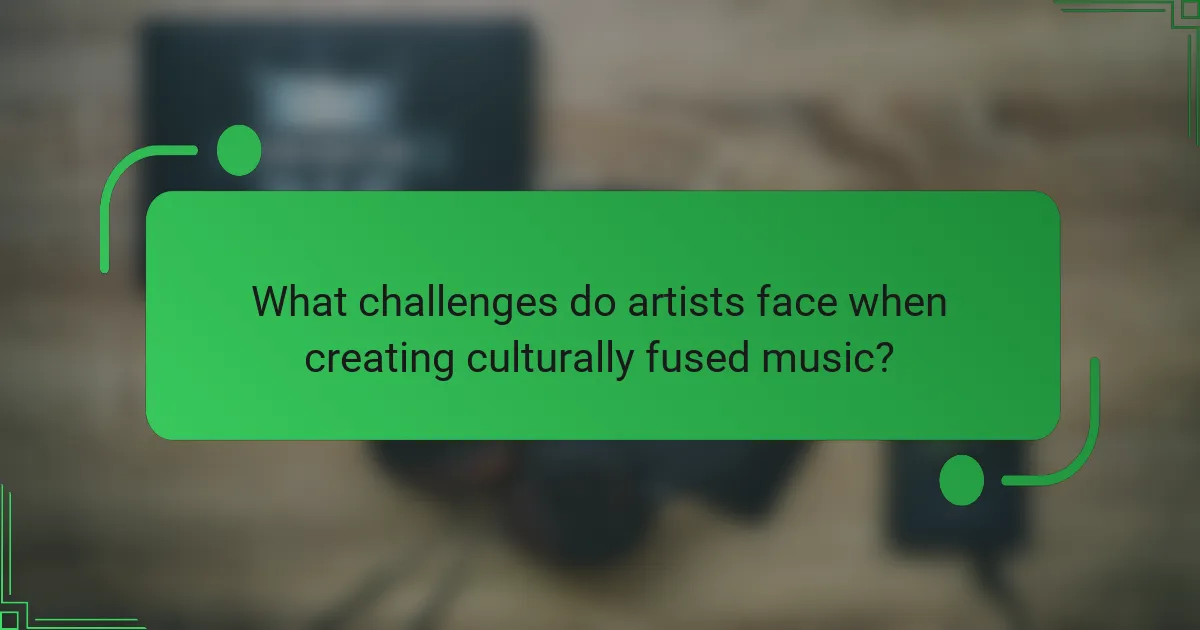Cultural fusion in indie music creates unique sounds that resonate with diverse audiences. This article explores key characteristics of genre blending, notable examples like Bon Iver and Vampire Weekend, emerging trends in collaborations, and the challenges artists face, including cultural appropriation. It also highlights ways to sustain and promote cultural fusion through community engagement and diverse representation.

What are the key characteristics of cultural fusion in indie music?
Cultural fusion in indie music blends diverse musical influences, creating unique sounds. Key characteristics include genre blending, incorporation of traditional instruments, and collaboration across cultures. This fusion often results in innovative lyrical themes and diverse rhythms that reflect global experiences. Artists like Bon Iver and Thao & The Get Down Stay Down exemplify this trend, showcasing how cultural elements enhance artistic expression.
How does cultural fusion influence musical genres?
Cultural fusion significantly enriches indie music by blending diverse influences, creating unique sounds and artistic expressions. This genre often incorporates elements from various cultures, resulting in innovative styles and themes. For example, artists might integrate traditional instruments from different regions, infusing their music with distinct textures. Trends show a growing appreciation for cross-cultural collaborations, which expand the genre’s reach and appeal. As a result, indie music becomes a platform for cultural dialogue, reflecting global interconnectedness while preserving local identities.
Which instruments commonly represent cultural fusion in indie music?
Instruments that commonly represent cultural fusion in indie music include the sitar, djembe, accordion, and steel drum. These instruments blend diverse musical traditions and enhance the genre’s eclectic sound. The sitar, with its unique timbre, often introduces Indian influences, while the djembe adds African rhythmic elements. The accordion brings in European folk influences, and the steel drum evokes Caribbean vibes. This variety illustrates how indie music embraces global sounds, creating a rich tapestry of artistic expression.
Why do artists choose to blend different cultural elements?
Artists blend different cultural elements to create unique expressions and connect with diverse audiences. This fusion allows them to explore new sounds, themes, and narratives that reflect a globalized world. For example, indie music often incorporates traditional instruments and styles from various cultures, enriching the overall sound. This trend not only showcases artistic innovation but also fosters cultural appreciation and dialogue.

What are some notable examples of cultural fusion in indie music?
Cultural fusion in indie music showcases diverse influences, blending genres and styles. Notable examples include the incorporation of Afrobeat elements by artists like Vampire Weekend, who mix Western pop with African rhythms. Another example is the melding of traditional folk sounds with electronic music, seen in the work of bands like The Lumineers. Additionally, artists such as Bon Iver infuse indie rock with elements of hip-hop and R&B, creating unique soundscapes. These trends reflect a growing appreciation for global musical traditions within the indie scene.
Which artists exemplify cultural fusion in their work?
Artists like M.I.A., Shakira, and Thao & The Get Down Stay Down exemplify cultural fusion in their work. M.I.A. blends South Asian influences with hip-hop and electronic music. Shakira combines Latin rhythms with pop and rock elements. Thao incorporates Vietnamese folk music into indie and folk genres. These artists showcase diverse cultural backgrounds, creating unique sounds that resonate globally.
How do specific songs reflect cultural blending?
Specific songs reflect cultural blending by incorporating diverse musical styles and themes. For example, artists like Vampire Weekend blend African rhythms with Western pop, creating a unique sound. Similarly, the band Dirty Projectors merges indie rock with elements of R&B and folk, showcasing cross-cultural influences. These artistic expressions highlight how music can transcend boundaries and foster cultural exchange. Trends in indie music increasingly feature collaborations across genres, further enhancing this cultural fusion.

What trends are emerging in cultural fusion within the indie music scene?
Cultural fusion in the indie music scene is characterized by blending diverse musical styles and influences. Emerging trends include collaborations between artists from different cultural backgrounds, the incorporation of traditional instruments into contemporary sounds, and the rise of genre-blending subgenres like worldbeat. These artistic expressions reflect global interconnectedness and resonate with audiences seeking authenticity and innovation. Notable examples include artists like Kishi Bashi, who fuses classical violin with indie pop, and the rise of Afrobeat influences in Western indie music.
How is technology shaping cultural fusion in indie music?
Technology is significantly shaping cultural fusion in indie music by enabling diverse influences and collaboration. Digital platforms allow artists from various backgrounds to share and remix their work, creating unique sounds. For example, streaming services facilitate global exposure, leading to the blending of genres like electronic and folk. Additionally, social media fosters community engagement, allowing fans to connect with artists and each other, further enriching cultural exchange. As a result, indie music continuously evolves, reflecting a fusion of traditions and modernity.
Which cultural events or festivals promote fusion in indie music?
Cultural events and festivals that promote fusion in indie music include global gatherings showcasing diverse genres. Notable examples are the Coachella Valley Music and Arts Festival, which features a blend of international artists, and the SXSW Music Festival, known for its eclectic line-up. These events encourage cross-cultural collaborations, fostering unique artistic expressions. Additionally, festivals like WOMAD celebrate world music, highlighting the fusion of traditional and contemporary sounds. These gatherings create platforms for indie musicians to experiment and innovate, enriching the music landscape.

What challenges do artists face when creating culturally fused music?
Artists face challenges such as cultural appropriation, identity representation, and genre blending when creating culturally fused music. Balancing authenticity with commercial appeal often complicates their creative process. Additionally, navigating diverse audience expectations can lead to misunderstandings or criticism. These factors can hinder artistic expression and limit the impact of their work.
How do cultural appropriation concerns impact musical expression?
Cultural appropriation concerns can significantly impact musical expression by fostering dialogue and awareness. Artists in indie music often blend diverse cultural influences, but they face scrutiny over authenticity and respect. This tension can lead to richer, more thoughtful artistic creations that honor the traditions they draw from while navigating potential backlash. For instance, collaborations between artists from different backgrounds can create unique sounds, but they must be mindful of the cultural significance behind those sounds. As a result, cultural appropriation discussions can encourage deeper engagement with the roots of the music, ultimately enriching the artistic landscape.
What role do audiences play in the acceptance of fusion music?
Audiences play a crucial role in the acceptance of fusion music by influencing its popularity and validation. Their diverse tastes shape the evolution of musical styles, encouraging artists to blend genres. As audiences embrace fusion music, they create demand for innovative sounds and collaborations. This acceptance fosters a supportive environment for artists to experiment, leading to the emergence of unique expressions that reflect cultural diversity. Engaged listeners also provide feedback, which can guide artists in their creative processes, reinforcing the connection between audience reception and artistic direction.

How can cultural fusion in indie music be sustained and promoted?
Cultural fusion in indie music can be sustained and promoted through collaboration, community engagement, and diverse representation. Collaborations between artists from different backgrounds create unique sounds and broaden audiences. Community events and festivals that celebrate various cultures foster appreciation and exposure. Additionally, promoting diverse voices in the industry ensures that cultural fusion remains vibrant and relevant. Engaging with social media platforms amplifies these efforts, allowing artists to connect with global audiences.
What best practices can artists follow to authentically represent cultures?
Artists can authentically represent cultures by engaging in research, collaboration, and respectful representation. Understanding the cultural context and history is crucial. Collaborating with cultural insiders fosters authenticity. Artists should avoid stereotypes and seek to elevate underrepresented voices. Engaging in cultural exchange promotes genuine artistic expression.
Which platforms are most effective for promoting culturally fused indie music?
Social media platforms, music streaming services, and niche blogs are most effective for promoting culturally fused indie music.
Platforms like Instagram and TikTok enable artists to showcase their unique sound visually, attracting diverse audiences. Spotify and Bandcamp allow for targeted music discovery, connecting fans with culturally rich indie genres. Additionally, niche blogs and online magazines can provide in-depth reviews and features, enhancing visibility among specific cultural communities.
What common mistakes should artists avoid in cultural fusion?
Artists should avoid cultural appropriation, lack of research, and oversimplification. These mistakes can lead to disrespect and misrepresentation of the cultures they aim to fuse. Understanding the nuances of cultural elements ensures authenticity and respect. Collaborating with cultural insiders can enhance the depth of artistic expression and prevent potential pitfalls.



